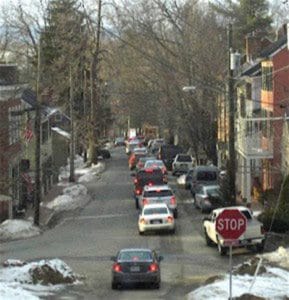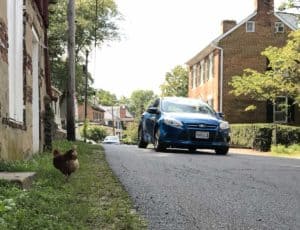Waterford Residents Pursue Traffic Reduction, Partnership with Historic Villages
LoudounNow, Dec. 22, 2016 by Margaret Morton
Warnings about heavy cut-through traffic rumbling through the historic village of Waterford have been cited as far back as the 1987 Waterford Area Management Plan.
It's a warning that's come home to roost.
Waterford Citizens Association President Wendy Roseberry says the topic is at the top of the organization's "must do" list. The group made progress in June when the Loudoun Board of Supervisors approved Supervisor Geary Higgins' (R-Catoctin) request for a grant to conduct a traffic study of the area, authorizing $82,500 for that purpose and directing Transportation and Capital Infrastructure to set the process in motion.
But leaders in the National Historic Landmark village know they are not alone in the fight. During a meeting of the Loudoun Coalition for Preservation and Conservation this year, it became evident that many of the county's older villages face similar challenges because of their locations on long-established roads.
"Wendy and [Waterford Foundation Preservation Director] Margaret Good and other coalition members were concerned with cut-through traffic," said Coalition President Al Van Huyck. When Roseberry cited the county study and pointed out the problem of cut-through traffic, others shared the same concerns, including Ard Geller, president of the Lincoln Preservation Foundation, and Mitch Diamond, representing Unison. As a result of those talks, a special rural village traffic workshop is being planned next spring, after the Waterford study is completed.
It also became evident that traffic is not the only problem shared by the rural villages. That has spurred talks of forming a coalition of representatives from the county's small historic communities.
What form the coalition would take is still up in the air. Roseberry, Van Huyck and others are contemplating an email platform to share ideas and to promote stronger policies to protect villages as the county's comprehensive plan is updated. After attending one of the recent Envision Loudoun listening sessions, Roseberry said the county was on board with the goal of protecting its historic villages from cut-through traffic, using Waterford as the model.
Roseberry, who was elected president of the WCA in January, previously chaired the association's Traffic Committee. She was told by a local law enforcement representative that the village had around 3,000 commuting trips per day. That led to the push that resulted in the county grant.
The Traffic Committee is now chaired by Mary Sheehan, who is looking at the county's Beaverdam Creek Historic Roadways District as a model that could help protect Waterford and other villages. Adopted in 2002, the overlay district applies to a network of 32 mostly rural, unpaved roads in southwestern Loudoun and enacts protections for trees, walls and other features that line them.
"We've seen the traffic at rush hour increase substantially," Sheehan said. The traffic study will show where cars are coming from and where they are going. The WCA hopes the results would qualify the village for the Virginia Residential Cut Through program, which could result in measures to discourage through traffic.
"Waterford streets are being used by arterial commuters—from Routes 15, 7 and 9," she said. "The data will be the first thing—where is it that people are coming from. We hope to identify the bottlenecks. We understand commuters want to streamline their alternatives, but we need to protect the landmark and be stewards of it," Sheehan said.
Meredith Imwalle, who chairs the WCA's Preservation Committee, agrees the county's villages are at a disadvantage because they have no formal government system to protect them. "It's not that we don't want commuters; we want them to engage with us and not just drive through," she said, calling the informal findings of 3,000 vehicles per day passing through Waterford's narrow streets as "mind boggling."
It's not the first time the village has tried to ease its traffic problems. The Waterford Foundation and the WCA in 2003 launched the Bury the Wires and Calm the Traffic Initiative, but only succeeded in completing the traffic-calming portion of the project—mainly adding more stop signs at village intersections.

